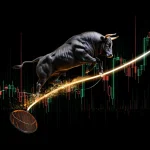
Introduction
Jan 14, 2025
Have you ever wondered why so many investors cling to an established trend, even when signs suggest an abrupt reversal is on the horizon? Market history is littered with speculative booms that transformed overnight into panics, catching unprepared participants off guard. This tendency to believe that present conditions will remain unchanged is a normalcy bias. It is a habitual pattern where individuals underestimate the likelihood of disruption, trusting that life will continue as it always has. Such thinking can be perilous in financial circles, especially when markets rise to unsustainable peaks or plunge into moments of despair.
Consider the dot-com fever around the turn of the millennium, when seemingly every technology start-up offered promises of untold riches. Company valuations soared far beyond any rational yardstick, yet investors continued to pour in, believing that the boom would last indefinitely. A similar story played out before the 2008 housing collapse when property prices skyrocketed, mortgage approvals became excessively lax, and warning signs of risk went ignored. In both instances, masses behaved like a permanent golden age had arrived, reflecting classic symptoms of normalcy bias. Once the mania ended, fortunes vanished in a flash, and those who resisted caution faced unexpected losses.
This essay will explore how such patterns relate to mass psychology, behavioural finance, and technical analysis. We will uncover why a strategic approach can often uncover hidden opportunities, especially when everyone else is in a frenzy to buy at inflated prices or sell during panic-laden crashes. Throughout these pages, real-world examples will highlight how crucial timing can be. By examining the signals provided by technical indicators, combined with an awareness of how crowds react to fear and euphoria, investors may learn that calm decision-making trumps reactive choices. The ideas here challenge conventional wisdom, urging a measured path that anticipates extremes rather than being blindsided by them. Ultimately, it is a reminder that market optimism and dread can move in cycles, and those prepared to navigate them can find steadier ground.
Normalcy Bias and Mass Psychology
Normalcy bias, at its core, is the mental habit of assuming that a disturbing event is unlikely to happen or, if it does occur, it will not derail everyday life. In financial terms, this can manifest as investors turning a blind eye to overblown valuations or underestimating the danger of unchecked speculation. Experts in behavioural finance point out that humans have a deep-rooted desire for stability, leading many to discount crucial signals until it is too late. This is partly why, throughout modern financial history, bubbles have swelled far beyond prudent limits before bursting catastrophically.
Mass psychology plays a large role in exacerbating the effects of normalcy bias. When a market’s ascent appears unstoppable, the majority often believes it will scale ever-higher peaks. This behaviour is reminiscent of crowds at a carnival who gather around a new act, refusing to consider that an abrupt end might be just around the corner. Such excitement is self-reinforcing as investors take cues from each other, intensifying the belief that today’s fortune-making will surely persist. By extension, warning voices become background noise, drowned by collective enthusiasm.
In practice, this phenomenon causes rational analysis to be overshadowed by wishful thinking. Instead of verifying a company’s earnings, debt levels, or growth prospects, market participants join the buying spree because the trend is positive. This was evident in the late 1990s during the dot-com surge, when people assumed every online business would be the next technology giant. In reality, many of these ventures lacked stable profits, but that did not deter crowds from funnelling in new capital. Similarly, in the run-up to 2008, more and more homebuyers and speculative flippers entered the property scene, stoking prices to heights that seemed unreasonable in retrospect.
When someone warns of a possible crash, normalcy bias often leads others to dismiss it as alarmist talk. Even if data demonstrates that mortgage default rates are rising or that tech start-ups are running out of cash, mania-driven minds cling to the idea that such evidence is a one-off exception. This tendency is also reflected in the well-known statement, “This time it’s different,” which inevitably resurfaces whenever an asset bubble enters advanced stages. It seldom turns out to be true.
Behavioural Finance: Emotions in Market Cycles
Behavioural finance researchers pinpoint fear and greed as two driving emotions behind market cycles. These qualities feed normalcy bias by prompting investors to tune out warnings and place faith in the status quo. When markets have been climbing steadily, fear of missing out causes many to stretch beyond sensible positions. In the euphoric phase, cheerleaders proclaim that gloomy forecasts have no basis, motivating even more people to join the rally. Meanwhile, greed pushes traders to hold onto positions long after standard risk management would suggest taking partial profits.
However, the same emotional circuits that lead to excessive zeal can pivot into panic once losses emerge. When prices start tumbling, the herd reverses course as quickly as it once charged forward. The fight-or-flight instinct takes over, compelling widespread selling and magnifying the downward spiral. This is where normalcy bias flips: after failing to acknowledge danger earlier, participants now may assume that markets will keep falling forever. The result: they sell at drastic lows, only to watch the market eventually rebound once cooler heads see value in the rubble.
Experts like Daniel Kahneman have long explained that human thought processes are prone to systematic errors, known as cognitive biases. Loss aversion, anchoring, and confirmation bias are just a few examples of mental shortcuts that frequently mislead individuals in stressful scenarios. Normalcy bias fits this pattern by encouraging complacency in times of easy gains, while fear triggers overreaction in the downturn. Although modern tools for data analysis abound, the unchanging reality is that our emotions often hold greater sway than logic. Thus, understanding the classical cycles of boom and bust means recognising these powerful emotional undercurrents.
It is not enough to wish away these tendencies. Investors should actively anticipate moments when normalcy bias can lead to exaggerated trends. When everyone is clamouring for growth stocks with no earnings, or when homebuyers rush to leverage themselves with massive loans, those who take a step back to question the pervading mood can save themselves from painful consequences. The message here is that ignoring typical emotional swings in the market can be disastrous. Instead, successful market players incorporate an understanding of mass psychology in their strategies, helping them avoid frenzied buying and panic selling.
Technical Analysis: Spotting Warning Signs and Opportunities
While normalcy bias is rooted in psychology, technical analysis systematically examines price and volume data for clues about potential market shifts. Indicators such as the Relative Strength Index (RSI), Moving Average Convergence Divergence (MACD), and various oscillators help traders gauge momentum. When price action contradicts these indicators, it can suggest that a bullish wave is losing steam or that a bearish slump may be nearing exhaustion. Such signals can be crucial in hinting that a widely shared belief in a never-ending rally (or freefall) is misplaced.
A historically significant example is how certain warning signs appeared before the dot-com crash. As technology shares soared, some technical indicators flagged an overstretched condition. Nevertheless, normalcy bias led many to disregard these signals, convinced that “clicks” and “eyeballs” on websites would translate into eternal prosperity. In the 2008 housing bubble, anecdotal reports of unlikely borrowers obtaining massive mortgages were public knowledge, yet property values continued climbing well beyond their long-term trendlines. Observers who checked price-to-income ratios or tracked deviations from typical growth rates could see that the party was overextended, but the exuberant general consensus drowned out such caution.
One hallmark of technical analysis is its focus on quantifiable aspects. While fundamental analysis looks at earnings, balance sheets, and macroeconomic data, technical charts reveal trading activity patterns that may reflect deeper psychological forces. For instance, if a stock’s price struggles to make new highs while volume declines, it might suggest buying enthusiasm is diminishing. Equally, if a sharp drop in prices coincides with subsiding selling pressure, a recovery could be in the offing. This objective approach can help traders and investors sidestep the illusions created by normalcy bias, shining a light on hidden shifts in sentiment.
However, technical analysis is far from foolproof. Chart signals can appear promising yet fail to deliver if broader circumstances change abruptly or if high-frequency trading distorts short-term movements. The best practitioners of this method combine their findings with sound risk management. They recognise that no indicator alone can guarantee profits, but ignoring price and volume patterns altogether often leaves one vulnerable to emotional whims. Adopting a measured stance that balances psychological awareness with chart-based strategies may help reduce the siren calls of normalcy bias.
Real-world Examples: Housing Bubble 2008 and Dot-Com Crash
The 2008 housing bubble is a classic illustration of how normalcy bias can infiltrate both household buyers and large financial institutions. At the height of the frenzy, many believed that property prices would continually rise, allowing anyone to refinance or flip homes for profit. This assumption was so deeply ingrained that major banks underwrote subprime loans with little regard for the borrower’s ability to repay. The general refrain was, “Real estate only goes up,” which reveals how rooted normalcy bias had become.
Yet, as soon as affordability faltered and mortgage defaults began to climb, the bubble popped. Technical data and fundamental ratios had been signalling trouble for a while—home prices had surged far beyond median incomes, for instance—but few paid attention. When the crash finally arrived, it unleashed a wave of foreclosures, bank failures, and a stock market in freefall. Investors who embraced contrarian thinking and reduced their property exposure during the boom were spared the worst devastation. Those guided solely by blissful assumptions saw their wealth evaporate.
A similar tale unfolded during the dot-com period of the late 1990s. Technology stocks soared in a seemingly endless climb, with start-ups that lacked any solid profits drawing millions in capital. The party spirit was so infectious that even seasoned professionals ignored valuations. Indicators that suggested an overstretched market—such as extreme price-to-earnings ratios and weakening internal momentum—were overshadowed by declarations that corporations tied to the Internet were destined for limitless expansion. In hindsight, the mispricing is glaring, but at the time, few were willing to face the possibility of a crash.
When the market reversed, it did so brutally, eradicating fortunes and throwing doubt on every rosy prediction that had fuelled the bubble. The lesson from both episodes is that normalcy bias prevents many from accepting that skies can darken quickly. Those who recognised the signals—whether from technical charts, fundamental data, or just plain caution—were better equipped to protect their capital and seize opportunities as values returned to sensible levels.
Timing the Market: Buying Panics, Selling Manias
A common saying in investment circles goes, “Buy when there’s blood in the streets.” Although it sounds dramatic, the expression points to a simple truth: moments of intense fear frequently offer the best entry prices for sturdy assets. When others sell in a frenzy, values can dip to levels that provide an attractive margin of safety. Taking advantage of such occasions requires going against the crowd, which is far easier said than done. Normalcy bias during a crash can lead one to believe that the downward spiral will never end. Yet, time after time, history shows that eventually, the gloom recedes, and markets recover at least part of their lost ground.
Equally, riding a bubble all the way up and failing to secure gains can be disastrous. Great traders often follow the principle of selling into strength, meaning they start locking in profits when the mania reaches its apex. They do this not because they can predict the precise day of the crash but because they realise that unchecked optimism rarely lasts. Technical signals can help identify periods of diminishing momentum where a pullback might be looming. By systematically reducing exposure, investors may walk away with their gains intact rather than lose them in the ensuing decline.
Of course, timing the market is notoriously challenging. There is no magic formula that sports tops and bottoms with perfect accuracy. Nonetheless, combining psychological awareness with chart-based evidence can tip the balance in one’s favour. Rather than relying on mere guesswork, enlightened traders look for markers of crowd euphoria or mass panic. They assess volume spikes, divergences between price and indicators, and shifts in broader economic conditions. By blending these factors, they stand a better chance of exiting near a peak or entering near a trough.
Steering Clear of Herd Mentality and Harnessing Contrarian Approaches
Herd mentality underpins some of the most dramatic booms and busts in modern times. In every bubble, there is a point where even sceptics feel pressure to join the stampede, fearing ridicule or missed profit opportunities. This social force can be overwhelming, as anyone with contrasting views may be labelled shortsighted. Normalcy bias merges with groupthink, producing a powerful wave of market participation that often seems unstoppable.
Contrarian investors deliberately swim against the current. Rather than accepting the main narrative, they dig into data and challenge the story everyone appears to believe. When they witness normalcy bias leading to wild overconfidence, they scale back or close positions. Conversely, when the herd is utterly convinced that disaster is permanent, contrarians begin to build positions in select opportunities, anticipating a rebound. Such strategies can feel lonely or even frightening at the time, but they frequently yield impressive returns when the herd’s convictions prove mistaken.
Warren Buffett famously stated: “Be fearful when others are greedy, and greedy when others are fearful.” This adage reflects a contrarian viewpoint that thrives on the cyclical nature of markets. However, it calls for strong discipline. It is no small task to sell part of your holdings when everyone around you is still buying at record highs, buoyed by normalcy bias. Likewise, investing in battered assets during a bear market requires strong nerves. Yet the consistent lesson from prior bubbles and their implosions is that sound judgment, guided by awareness of behavioural pitfalls, often surpasses the comfort of going with the masses.
Building a Measured Mindset for Long-Term Success
Developing a measured mindset involves recognising that cognitive biases, such as normalcy bias, will always be present. The challenge is not to eliminate them but to manage their effects. This can be achieved through several practical steps. First, keep a record of trades, including the reasons for each decision and the emotional climate at the time. By reviewing this log, investors can detect patterns in their own thinking and begin to correct them.
Second, implement rules that limit impulsive behaviour. For instance, some traders predetermine entry and exit points based on both technical indicators and logical assessments of value. That way, when the market swings wildly, they are less tempted to abandon their plans due to short-term emotions. Third, maintain a degree of scepticism when the market message proclaims that a new era of endless growth has arrived. No market goes straight up forever, and even the most promising sector can falter if it becomes overpriced.
Finally, remain aware that normalcy bias may block out warning signs. By actively seeking contrary evidence, investors can reduce the risk of falling for illusions of endless bull trends. A willingness to explore worst-case scenarios might feel uncomfortable, yet it can be a critical safeguard against losing capital when bubbles burst. In simple terms, constant vigilance is key. Instead of presuming that tomorrow will mirror today, it pays to prepare for a range of outcomes guided by a blend of informed analysis and emotional balance.
Conclusion
Why do so many talented people fail to notice oncoming crashes until it is too late? A major culprit is normalcy bias, which lulls investors into believing that what seems ordinary now will continue indefinitely. When paired with herd mentality and emotional extremes, this bias can lead to enthusiastic buying at the most perilous junctures or hasty selling just as a market is about to reverse. The resulting boom-and-bust cycles may look inevitable in hindsight, but they result from predictable weaknesses in our thinking.
Markets move in waves, pushed and pulled by collective psychology. While no indicator or approach can provide absolute certainty, a blend of technical analysis and behavioural awareness offers a powerful toolkit for those willing to question the apparent safety of the present. Monitoring divergences, volume trends, overbought or oversold readings, and macroeconomic signals can encourage more thoughtful decisions. Above all, adopting a strategic posture means respecting the lessons of history: booms never last forever, and busts often pave the way for future recoveries.
Ignoring normalcy bias is not an option for investors and traders aiming to build long-term success. Instead, they should recognise how it manifests, accept that emotional impulses guide market players more than they might care to admit, and plan accordingly. One can position capital with greater precision and peace of mind by anticipating fear and greed rather than reacting to them. That is the art of balancing rational analysis with an understanding of our collective penchant for complacency. In short, remain watchful, question the popular consensus, and never underestimate how swiftly a market can change its tune when crowd sentiment shifts. Doing so stands to protect gains in euphoric periods and exploit good bargains when others only see trouble.












